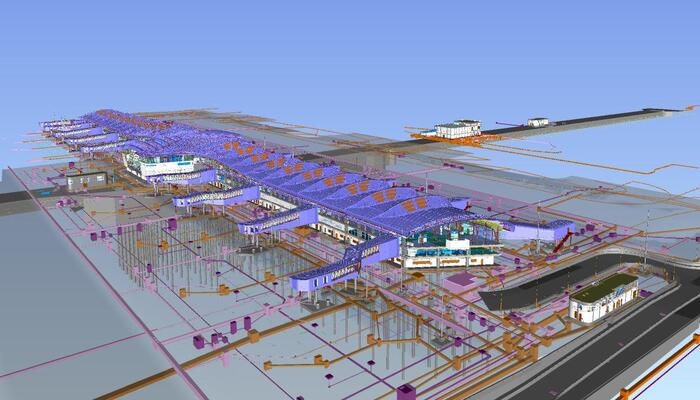Top BIM Trends for Civil Engineers to Know in 2025 (Updated)

Table of Contents
BIM, or Building Information Modelling, is a synergetic process that helps create digital twins of buildings and infrastructure. From design to execution, this model is used for planning, design, construction, and operation, making it highly collaborative. The BIM trend for civil engineers also helps in creating visualisation in a simulated environment, which helps stakeholders envision potential designs, operational issues, and construction processes.
BIM acts as a resource for facilitating information and decision-making during construction processes. In the field of civil engineering, BIM trends assist with the construction, designing, and management of civil infrastructure projects like bridges, tunnels, roads, and water management systems.
Read more: Role of BIM in Constructing the Fehmarnbelt Tunnel
The Adoption of BIM Trends for Civil Engineers
Did you know that almost 70% of civil engineers have adopted the global trend of BIM since 2016? According to a recent report by Dodge Data and Analytics, civil engineers are adopting BIM aggressively, and so is the Architecture, Engineering and Construction (AEC) industry. The civil engineering industry is shapeshifting to tech-driven processes, and without Building Information Modelling in your skill book, you might be missing out! The BIM trend for civil engineers is a step ahead of traditional engineering applications and makes the execution of construction projects efficient, collaborative, and precise.
By incorporating 4D (time) and 5D (cost) aspects, BIM magnifies project planning and control, leading to improved visualisation. Cost and time factors help keep tabs on progress, fine-tune schedules, allocate resources, and monitor the construction sequence. By integrating AI and GIS, we are looking at BIM trends for civil engineers in managing infrastructure assets efficiently. Other latest construction technologies and modern applications of BIM include virtual environments, prefabrication, and sustainable design.
Benefits of BIM on the Construction Job Market

As an AEC professional, who doesn't want lesser reworks, efficient project planning, and better teamwork? That's where new innovations in civil engineering come into play. Implementing BIM as an industry trend has changed the face of civil engineering by streamlining processes, saving costs, and avoiding clashes. With BIM's data-driven insights and enhanced alliance, it has proven to be a ground-breaking technology for civil engineers. So, if you are willing to explore smoother project implementation, successful project design and efficient working, then read further to explore the benefits of the BIM trend:
- Improved Communication and Collaboration: The global trend of BIM facilitates a platform that offers better collaboration between stakeholders. This further streamlines workflows, resolves clashes, and enhances decision-making and communication.
- Enhanced Visualisation: BIM excels in creating precise 3D models that improve visualisation and help understand complex projects.
- Enhanced Efficiency: BIM smoothens design and construction processes, cutting down time and resources required to wrap up a project.
- Cost Savings: BIM can be employed in reducing errors and rework by identifying potential issues in the early stages of the project. This ultimately makes it easy on your pockets and saves time as well!
- Better Project Management: BIM also facilitates streamlining execution and performance tracking, leading to efficient project management.
Top BIM Trends for Civil Engineers

The AEC industry is undergoing a fundamental shift that prioritises safety, regulations, and integrating tech in processes. The upcoming era of construction is anticipated to incline towards efficiency and sustainability, making it a prevalent global trend. With the development of infrastructure and the urban fabric, the urgency to adopt such practices is expanding with time. These trends are the future of BIM in civil engineering and majorly include smart tech, green buildings, sustainability, integrated transport systems, modular construction, virtual environments, and much more.
Read more: How is BIM Used in Urban Planning
Now, let us discuss the emerging trends in civil engineering in detail and understand how they predominantly benefit the overall construction industry. Listed below are some of the prominent BIM trends for civil engineers:
1. Prefabrication and Modular Construction
Many engineers, subcontractors, and general contractors find common ground in implementing modular construction and prefabrication techniques. This concept primarily involves fabricating building components in a factory, assembling them, and transporting them to the site for the congregation. This ultimately yields benefits like reduced waste and costs, increased efficiency in project delivery, and better management.
Read more: How Tesla is Using Prefabrication as an Innovative Way to Build its Factories?
2. Cloud Collaboration
According to CloudTweaks' reports, 87% of construction companies are willing to position cloud-based software in the coming years for their projects. So, the question pertains: Is cloud collaboration the new prerequisite in the AEC industry? With the growing population and expansion of the urban skyline, the demand to create settlements and establishments is skyrocketing. With this, the AEC industry is inclining towards efficient and precise processes and methodologies. Offering real-time data sharing and project insights, this latest technology in civil engineering leads to precision, efficient collaboration, cost saving, timely deliverables, and team productivity.
3. Virtual Environment

Virtual environment technologies such as Augmented Reality (AR) and Virtual Reality (VR) significantly enhance building designs by improving visualisation. VR creates an immersive three-dimensional space experience, which helps better understand spatial relationships and design aesthetics. On the other hand, AR overlays digital information into the real world, helping in on-site construction work. These technologies not only make it easier to examine large-scale 3D models efficiently but also provide a clear and comprehensive view of design and its development. By combining VR and AR, stakeholders can enjoy virtual walkthroughs of projects, which reduces errors and improves communication, thereby enhancing the overall modelling process.
4. Digital Twins

A digital twin is an excerpt from the global trend of BIM that is efficient in solving operation management issues and ensuring cost reduction, streamlined deliveries, and enhanced precision. Allowing simulation, informed decision-making, and prediction in real-time, this technology employs intelligent multidimensional models. Many organisations use digital twins to analyse performance and observe occupants' behavioural patterns.
5. Automation

Industry experts have predicted the future of design in construction and quoted it to be more data-driven. Furthermore, the increasing demand for visual programming will allow architects and designers to leverage customised automation. Hence, personalising BIM software tools according to the design processes will lead to enhanced efficiency. Technologies like Artificial Intelligence (AI) also assist in streamlining construction processes, reducing costs and time, and checking the risks involved during a project lifecycle.
6. Data Source Connectivity

A data source connection highlights the parameters that are required to connect to a specific database, such as the location or the timeout duration. In the construction industry, combining the Internet of Things (IoT) and Big Data analysis, alongside construction technologies like drones and cloud computing can lead to an unconventional transformation. This combination allows stakeholders to distribute and access important data seamlessly. Specifically, BIM incorporates IoT sensors and devices into projects, facilitating real-time monitoring and control of systems such as HVAC, lighting and security. The use of real-time data, updated through cloud technologies, improves operational and construction efficiency.
7. Sustainability

Eco-friendly, sustainability, and energy efficiency are running in the news of the AEC industry. Several environmental factors, such as climate change and water shortage, significantly impact housing and livability. During times like these, building environment-sensitive and ecological designs become essential. Designers and engineers can be seen indulging in solving this crisis and charting out methodologies that would help reduce the carbon footprint and consume less energy using sustainable and vernacular materials.
Essential BIM Tools and Software Trends

Civil engineering software can be employed as solutions in structural analysis, project management and model design. Some of these tools include Computer-Aided Design (CAD), road and bridge network modelling, geological modelling, impact analysis, event simulation, and building structure visualisation.
Here are 5 essential tools and software for civil engineers:
1. Autocad:
Allows designers to work in 2D and 3D along with a wide range of collaboration tools.
2. Revit:
A BIM tool that provides analysis for streamlining workflows, it can be used in architectural, Mechanical, Electrical and Plumbing (MEP) industry, structural and engineering design.
3. Sketchup:
A 3D modelling software that emphasises utilisation. This also assists in visualisation and designing in 3D.
4. Civil 3D:
Supports different civil projects including highways, rails, roads, land development, airports, drainage, storm and sanitary.
5. Solidworks:
A system that offers resources, electrical design, 2D and 3D designs, simulations, and product development using collaborative tools.
Sustainable Practices in Civil Engineering

With the growing demand for energy conservation and sustainability, many firms in the AEC industry are beginning to acknowledge the significance of green building and sustainable methods. To this end, advancements in technology, materials, and practices have been developed to catalyse efficiency.
The field of ergonomic construction talks about implementing sustainable efforts. Some of the practices include:
- Shifting to green building construction
- Implementing waste management
- Energy conservation
- Reducing waste by restricting material usage
- Transforming old buildings by adaptive reuse
- Opting for sustainable and recycled materials
- Efficiently managing construction sites to enhance conservation
Future of BIM Trends for Civil Engineers
The global trend of BIM and how it is crucial for the future of building and construction, are creating buzz in the civil engineering industry. With advancements in technology, BIM is developing into an essential component in infrastructure and construction practices. BIM is going to be the next big thing for the AEC industry and will continue to transfigure construction, project design, and management.
The scope of the global trend of BIM includes utilising the model at multiple stages to improve collaboration. The multifarious applications of BIM make it an indispensable tool for civil engineers and allow them to construct buildings efficiently and sustainably. With emerging initiatives like 'Women in BIM' and the global expansion of tech, BIM future trends in the civil engineering industry are bound to become digitised and collaborative.
How to stay up-to-date on BIM trends?
BIM is not only a tool, it’s a cooperative mindset of collaborating and working efficiently and productively, enhancing project development. With the AEC industry being swayed by the wave of technology, it can be overwhelming for professionals to stay updated with it. But, while we all are running in the same marathon, let us make it easier for you to stay ahead.
- Subscribe to blogs and newsletters related to BIM for civil engineers
- Get connected with BIM networks and communities
- Stay on the edge of your seat and keep looking for events and webinars related to the industry or BIM for civil engineers
- Enrol for BIM certifications and courses for civil engineers
- Keep experimenting with BIM tools and software
Read more: 3 Best Ways to Learn and Benefit from BIM in Civil Engineering
Conclusion
Staying ahead of the curve in the continuous world of civil engineering is paramount, and adapting to a technology like BIM has become quintessential. The global trend of BIM is not only transforming methodologies and construction processes but is also integrating new innovations in civil engineering like AI, machine learning and cloud-based platforms. Shapeshifting to sustainable practices, and making construction more efficient, productive, and collaborative is AEC's new mantra.
The world of AEC is ever-evolving and while it is embracing a technology like BIM for civil engineers, it will continue to adapt to new trends and bring in exciting eras of innovation, progress, and construction practices. So, let's gear up and be a part of a sustainable and tech-first construction era via the power of BIM.
So, if you are interested in learning more about BIM modelling, here’s something that might interest you. Novatr offers a BIM Professional Course for Civil Engineers that will help you understand industry workflows and advanced tools for streamlined construction processes. Learn high-performance computational BIM and building analysis via a live industry project. Bag opportunities along with professional certification, endless career possibilities, and upskilling.

 Thanks for connecting!
Thanks for connecting!

.png)
.png?width=720&height=158&name=BIM-C%20A%20(Course%20Banner).png)
.png)






-1.png)

